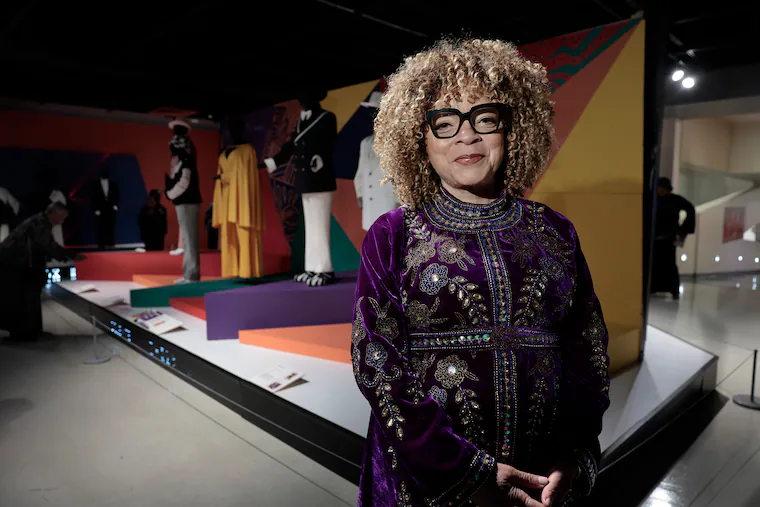Copyright The Philadelphia Inquirer

When Oscar-winning costume designer Ruth E. Carter signed on to outfit the cast of Ryan Coogler’s Mississippi Delta vampire film, Sinners, Coogler made one non-negotiable request. “He told me Smoke had to be in blue and Stack had to be in red,” Carter said. “And I wondered, ‘How was I going to make this work?’” Carter, not one to fret long, dove into her arsenal of research. By the time she began the fittings for actor Michael B. Jordan — who played both Smoke and Stack — she’d amassed an array of blue and black looks befitting of the 1930s sharecroppers-turned-bootleggers and juke joint owners. “[And] when I put that red fedora on him, Ryan flipped out and said, ‘That’s it.’” The moment the Smokestack twins appeared on screen, it was clear that this would be another of Carter’s iconic film wardrobes. Stack — impeccably dressed in black pinstripes with a red tie, red pocket square, and a mouthful of gold fronts — was the fiery twin. His brother, Smoke, in a blue tweed suit, sky blue shirt, and teal newsboy cap was the calm and thoughtful brother. “We wanted people to resonate with their clothing and it did. Look what happened on Halloween,” she said referring to social media posts of revelers dressed as Smoke and Stack. The Smokestack twins’ costumes are among the more than 80 looks featured in the African American Museum in Philadelphia’s latest exhibit, “Ruth E. Carter: Afrofuturism in Costume Design.” The Sinners’ pieces join looks from Malcolm X, Lee Daniels’ The Butler, Coming 2 America, Black Panther, and its sequel, Black Panther: Wakanda Forever. “Afrofuturism in Costume Design” kicks off AAMP’s yearlong 50th birthday celebration and its commemoration of America’s Semiquincentennial. It will remain up through Sept. 6. “It feels incredible to be here,” Carter said to a standing-room-only crowd last week in AAMP’s Jack T. Franklin Gallery. She wore the floor-length purple gown her late mother, Mabel Carter, wore to her 100th birthday four years ago. For Carter, the exhibit is as much an homage to her mother as it is to her. “I think the Founding Fathers would be proud,” Carter said. “But they probably wouldn’t know what to do with all this Wakandan energy.” Carter’s 37-year film career is vast. Her films are events, portals into the moment’s cultural zeitgeist. In both 2018 and 2022, moviegoers inspired by Carter’s Wakandan fashion flocked to Black Panther movies in Ankara gowns and kente cloth suits. Carter won the Academy Award for costume design for her work on both Black Panther movies and years later, Black Panther remains a top Halloween costume for children. I’ve seen every movie Carter has outfitted, most of them several times. Images of Angela Bassett as Tina Turner rocking a litany of tasseled frocks in the 1992 biopic What’s Love Got to Do with It is seared in my brain. The shorts and shimmering sheaths Monica Wright (Sanaa Lathan) wore in the 2002 romance Love & Basketball were in my closet, too. Carter’s works are cinematic photo albums, big screen documentations of where Black Americans have been, who we are at any given moment, and who we dream of becoming. Her five decades of movie work has shaped how the world sees African Americans. Her impact on the way we are perceived is unparalleled. “I am a griot,” Carter said to The Inquirer. “[Throughout my career,] I’ve developed a knowledge base that embraces our culture and speaks to all of us in a positive way.” She grew up in Springfield, Mass., the youngest of eight, and taught herself how to sew on a sewing machine gifted by her mother. She went to Hampton University in the 1980s, majoring in theater arts. After a professor asked her to design costumes for one of his plays, she became the go-to designer for Hampton’s plays, musicals, and step shows. After graduation, she interned at the Santa Fe Opera House and moved to California in 1986 to work for the Los Angeles Theatre Company. While working as the costume designer for a traveling dance troupe, she happened to meet a young filmmaker namedSpike Lee. Two years later, Lee hired Carter as the costume director for his 1988 film School Daze, set at the fictional historically Black Mission College. Carter had never worked on a film before, but as a Hampton graduate, she was well-versed in HBCUs. School Daze marked the beginning of Lee and Carter’s prolific 25-year film journey that includes the seminal films Do the Right Thing, Mo Betta Blues, Jungle Fever, and Malcolm X. Malcolm X earned Carter her first Oscar nomination, in 1992. In the decades since, Carter has kept her costumes in storage, “saving a few of her children” from each film. In the 2010s, a friend suggested she plan a museum exhibit. After Black Panther, she partnered with Marvel and in 2019, “Afrofuturism in Costume Design” debuted at the Savannah College of Art and Design’s Atlanta Campus. Philadelphia is the exhibit’s ninth — and longest — stop. It’s also the first stop for the Sinners costumes. “Afrofuturism in Costume Design” spans three galleries at AAMP, starting on the second floor with Black Panther and Coming 2 America ensembles. The late Chadwick Boseman’s Black Panther’s vibranium — it’s fashioned from a stretchy Eurojersey — stands tall surrounded by Erik Kilmonger’s (Jordan) denim look and the sleek Dora Milaje’s warrior costume. Hakeem (Eddie Murphy) and Semmi’s (Arsenio Hall) velvet tuxes stand behind them, in all their regal glory. Third-floor visitors are greeted by Carter’s childhood sewing machine. That gallery also features recreations of 17th-, 18th-, and 19th-century outfits seen in 1997’s Amistad and the 2016 reboot of Alex Haley’s Roots. Nearby, mood boards show how Carter developed these looks. “I love doing the research that lets me dive into these eras,” Carter said. To prepare for period movies, she studies centuries-old photographs and newspaper clippings. She has a large collection of Ebony and Jet magazine covers and Sears & Roebuck catalogs. That’s how she gets a sense of what people were wearing at the time. Then, she lets her imagination and the souls of the characters guide her. “I do so much work that when I’m done, I’m walking around in the eras,” Carter said. The third gallery holds fashions from the Spike Lee flicks. I lingered in front of Malcolm X (Denzel Washington) and Shorty’s (Lee) loud zoot suits. They look so small in person. I kept going back to the Do the Right Thing tableau where Mookie (Lee), Radio Raheem (Bill Nunn), and Tina’s (Rosie Perez) bright athletic wear took me back to my childhood. I realize now they are also a precursor to Cross Colors, one of the first hip-hop inspired fashion lines. Fashion. Art. Life. Movies. History. Afrofuturism. It’s all interconnected. “There is a divine alignment in how I tap into the wearable art form that is costume design,” Carter said. “The response from [moviegoers] validates that I did the right thing and it propels me to do the right thing again and again.”



